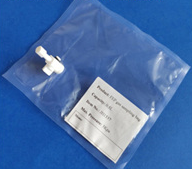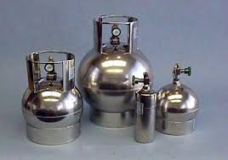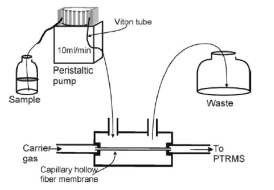What is SIFT-MS?
Selected ion flow tube mass spectrometry (SIFT-MS) is a form of “electronic nose” technology that delivers real-time quantitative analysis of volatile compounds by applying precisely controlled soft chemical ionization. The machine we are using jointlly with Analytica Laboratories is manufactured by a New Zealand company SYFT Technologies.
SIFT-MS is a less-costly and faster alternative to traditional gas chromatography/mass spectrometry (GC-MS) method for gas chemical testing. Compared to GC-MS, it does not require chromatographic analyte separation, and could immediately test complicated mixtures made of different classes of compounds (e.g. alcohols, amines, syloxanes etc.)
The performance of SIFT-MS and GC-MS methods was compared (Langford V.S. et al, Rapid monitoring of volatile organic compounds: a comparison between gas chromatography/mass spectrometry and selected ion flow tube mass spectrometry, Rapid Commun. Mass Spectrom. 2014, 28, 10–18)
The results of this comparison on selected compounds are shown below:

In one simple run, SIFT-MS can rapidly quantify a wide range of diverse volatile compounds – both organic and inorganic. Reliable results can be obtained with as little as 100 mL of sample. This method is an affordable way of routine monitoring of chemical contaminants, manufacturing processes, production quality etc.
This technology is an innovative solution to measuring environmental and food volatile chemicals in air with typical detection limits at parts-per-billion level by volume (ppbv).
Scope of testing
We at XR Pharmaceuticals offer an expanded range of services based on gas testing by SIFT-MS. These include consulting on customer projects, field work (including actual air sampling), R&D work, custom experimental setups. The examples of the latter are: study of chemical kinetics (including model development), human and animal breath testing for biomarker and diagnostics research, materials emissions at different temperatures etc.
The companion method to SIFT-MS is Cavity Ringdown Spectroscopy (CRDS), together with an electrochemical sensor for oxygen. It lets us to measure ppmv levels of carbon dioxide, percentage of oxygen, and isotopic composition of CO2 (δ13C).
SIFT-MS test method descriptions
| Test | Description |
|---|---|
| MASS SCAN | Qualitative and semiquantitative analysis of volatile organic compounds (VOC) in an air sample. Limit of quantification is 100 ppbv. |
| CUSTOM MASS SCAN | Qualitative and semiquantitative analysis of volatile organic compounds in an air sample, including those absent from the instrument library (if possible) |
| CUSTOM SIM (selected ion mode)* | Quantitative targeted analysis of a limited set of VOC in an air sample. Limit of quantification is 5 ppbv. If method is not available, it must be developed (or amended). Setup fee is charged per batch of samples if they require preparation step (e.g. dilution, headspace transfer etc.) Ready to use SIM methods are available for BTEX, reduced sulphur compounds (RSC), aldehydes, siloxanes. |
| Landfill Gas testing (LFG2, NMOC, CH4 & H2S, Siloxanes) | LFG2: screening test for ~40 common VOC's in the landfills; NMOC (non-methane organic compounds): total content of organic VOC, expressed in mg/m3 of hexane equivalent; |
| Adding a compound to the instrument library | Physical measurement of a sample of new VOC to add its parameters to the instrument library (for further inclusion in the methods). |
| CO2, O2, δ13C by CRDS | Analysis of carbon dioxide, including carbon-13 CO2 by cavity ringdown spectrometry; analysis of oxygen percentage by an electrochemical sensor. |
| Commented report | Additional information on the compounds in the report, on request. |
| Field work, sampling, staff training | Physical involvement of our staff in the described activities. |
| Consulting, R&D | Consulting and R&D work, on request. |
| Urgent reporting (same day, subject to availability) | 30% of total |
| Turnaround time | Up to 5 work days |
*SIM methods available (no method development is needed)
| BTEX (benzene, naphthalene, and their common homologues) | Benzene, mono-, di-, tri-, tetramethyl benzenes, styrene, naphthalene, methylnaphthalenes. |
| RSC (reduced sulphur compounds) | Hydrogen sulfide, methyl mercaptan, carbonyl sulfide, dimethyl sulfide + ethyl mercaptan (total), carbon disulfide, dimethyl disulfide |
| SILOXANES | Trimethylsilanol, hexamethyldisiloxane, octamethyltrisiloxane, tetramethylsilane, octamethylcyclotetrasiloxane, decamethylcyclopentasiloxane, decamethyltetrasiloxane |
| ALDEHYDES | Formaldehyde, acetaldehyde, glutaraldehyde |
Testing media and setups
| Medium | Available | Sampling equipment available for hire | |
|---|---|---|---|
 | Foil bags, 0.5L | Yes | Yes, single use bags and sampling pump. |
 | Fluorinated ethylene propylene (FEP) bags, 0.5L, for demanding tests (e.g. mass scan) | Yes | Yes, single use bags and sampling pump. |
 | Headspace testing for liquids | Yes | No. Client is expected to send in the liquid sample in an appropriate container. |
 | Headspace testing for solids (materials emissions) | Yes | No. Client is expected to send in the solid sample in an appropriate container. |
 | Canisters | Yes | No |
 | Thermal desorption tubes (including sorbent tubes and custom media) | In development | Possibly. Please inquire. |
 | Human and animal breath, direct testing | Yes | No |
 | Membrane introduction SIFT-MS* | Yes | No. Client is expected to send in the liquid sample in an appropriate container. |
* Membrane Introduction SIFT-MS is a faster and more reproducible variant of headspace testing for liquids. It is more useful for targeted quantitative analysis.
How to take a sample
Customers can use their own bags and sampling equipment, or they can hire both at the costs listed in the pricing section. If several methods are required for the same sample, we can do them all from a single bag (0.3–0.5L). If needed, we can do the sampling and/or provide training to the customer staff.
We can test from standard canisters, but we do not have them for hire. Gas samples have limited lifetime (approximately 48 hrs), and must be analyzed on the day they are received. We should be notified no later than noon on the working day prior to receiving the samples.
